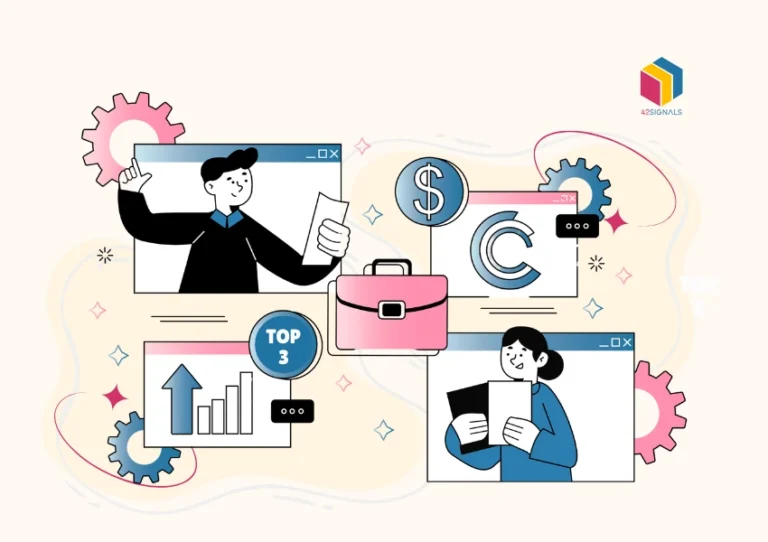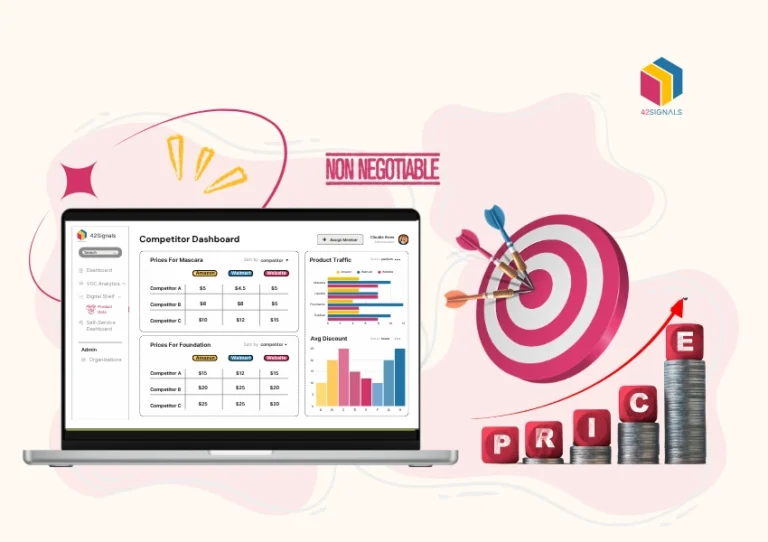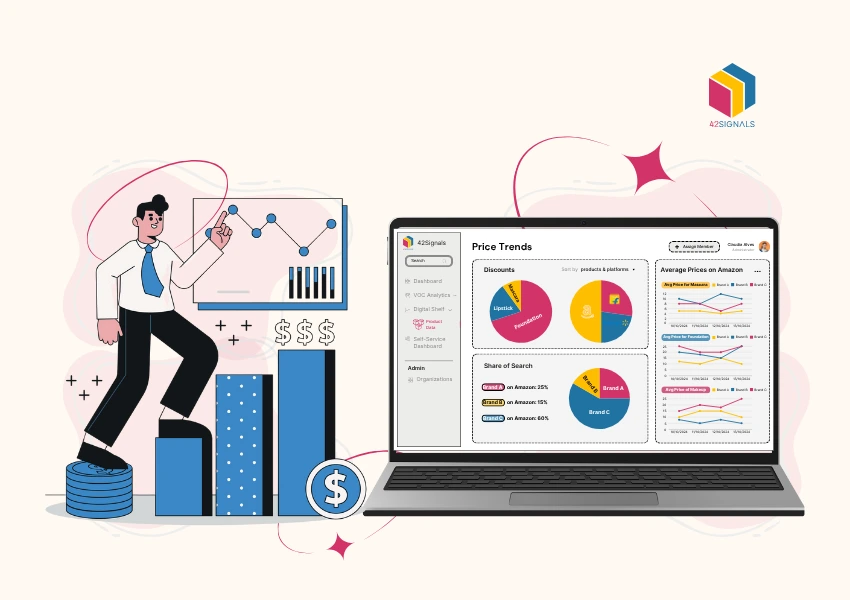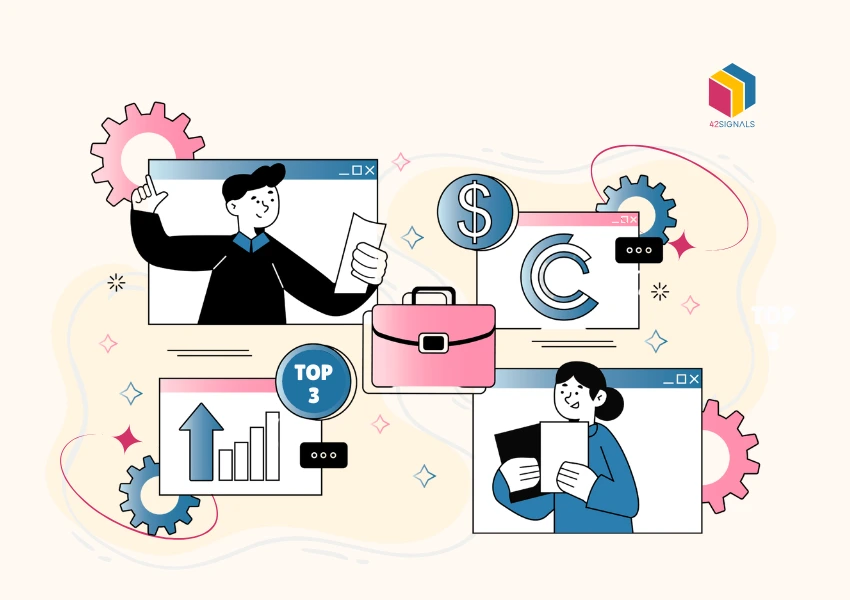Table of Contents
Toggle** TL;DR ** In today’s market, competitive pricing intelligence—the process of systematically tracking and analysing competitors’ prices—is non-negotiable for business success. It moves you beyond guesswork by using data to inform your pricing strategy, ensuring you protect profit margins, improve visibility, and win customers who constantly compare prices. While this can be done manually, specialised price tracking software automates the process, allowing you to monitor competitor prices in real-time and leverage dynamic pricing. Ultimately, adopting this approach is essential for making informed decisions, refining your market positioning, and gaining a significant competitive advantage.
Remember the last time you tried to price a product? Maybe you looked at what your competitors were charging, added a bit because you believe your quality is better, or subtracted a bit to attract customers. It feels like a logical approach, right? But in today’s fast-paced, digital marketplace, that kind of informal guesswork is a one-way ticket to leaving massive profits on the table or, worse, pricing yourself out of the market entirely.
What if you could know, with certainty, the perfect price for your products at any given moment? What if you could see not just what your competitors are charging today, but how they react to your changes, market trends, and even the time of day? This isn’t a fantasy. It’s the reality for businesses that have embraced a powerful, data-driven approach known as competitive pricing intelligence.

In simple terms, competitive pricing intelligence is the process of gathering, analysing, and using information about your competitors’ pricing strategies to inform your own. It’s about replacing intuition with insight and fear with foresight.
What is Competitive Pricing Intelligence? (A Simple Breakdown)
At its heart, competitive pricing intelligence is just a fancy term for keeping a close, systematic eye on your competitors’ prices. But it goes far beyond occasionally checking a rival’s website. It’s a continuous cycle of collecting data on their pricing models, discount patterns, promotional strategies, and shipping costs across various sales channels, including their own websites and major online marketplaces.
Think of it as giving your business a powerful microscope to view the market. You are not just seeing a static number. You are observing a dynamic, living ecosystem of prices. This process allows you to understand the why behind a price, not just the what.

Image Source: Competitors App
For instance, if a competitor lowers their price, is it a permanent shift, a short-term flash sale, or a reaction to a stock clearance? Competitive pricing intelligence provides the context to answer these questions, transforming raw data into an actionable business strategy.
This intelligence feeds directly into several key business areas, helping you make smarter decisions about your pricing strategy, optimise your market positioning, and leverage retail analytics for growth. It’s the foundational layer that makes advanced tactics like dynamic pricing possible.
The Stakes Are High: Why Competitive Pricing Intelligence is Non-Negotiable

Image Source: 42Signals Competitor Analysis Dashboard
In a world where 87% of shoppers check online reviews and compare prices before making a purchase (according to a 2023 report by BrightLocal), being competitively priced is not just an advantage; it’s a baseline customer expectation.
The reasons for making this a core business function are compelling:
- Protect Your Profit Margins: Price too low, and you start a race to the bottom, eroding your profits until your business is no longer sustainable. Price is too high without a clear value proposition, and you drive customers directly into your competitors’ arms. Intelligent pricing helps you find that sweet spot where you maximise revenue without sacrificing sales volume.
- Win the Battle for Visibility: On Amazon and other e-commerce platforms, the pricing algorithm heavily favours competitively priced products. A better price can lead to a higher ranking, which in turn leads to more visibility and more sales. Without competitor price tracking, you are essentially invisible to these powerful algorithms.
- Make Data-Driven Decisions, Not Emotional Ones: It removes the guesswork and internal debates. Should we match that price? Should we run a promotion? The data from your pricing intelligence efforts provides a clear, unbiased answer, empowering you to lead with confidence.
In short, competitive pricing intelligence is non-negotiable because your competitors are almost certainly already doing it. Operating without it means you are willingly ceding a significant competitive advantage.
How Does Competitor Price Tracking Actually Work?
So, how do you actually gather this valuable intelligence? The process can range from manual to fully automated, but the goal is the same: collect accurate and timely data.
- Manual Methods: This involves physically visiting competitor websites and online marketplaces to record prices, stock status, and promotions. While this is a low-cost starting point, it is incredibly time-consuming, prone to human error, and impossible to scale. You might be able to track a handful of products for a few competitors, but for a business of any significant size, this approach is not viable.
- Automated Price Tracking Software: This is where modern technology takes over. Specialised price tracking software uses web scraping bots and data extraction tools to automatically and continuously collect pricing data from a vast array of competitor websites. These tools can track thousands of products across dozens or even hundreds of competitors, 24/7, without fatigue.

This automation is the game-changer. It ensures you have a constant, real-time flow of data, allowing you to see patterns and react to changes almost instantly.
This automated data collection is the fuel for advanced retail analytics and is the backbone of any serious pricing strategy in the digital age. The ability to monitor competitor prices at this scale and speed is what separates market leaders from the rest.
Beyond the Number: What Data Should You Actually Track?
When you set out to monitor competitor prices, it’s tempting to focus only on the final selling price. However, true intelligence comes from looking at the entire pricing picture. Your tracking should encompass:
- Base Price and Promotional Discounts: What is the standard price, and how frequently do they run sales? What do their “20% off” or “BOGO” campaigns look like?
- Shipping Costs and Thresholds: A product priced at $50 with $10 shipping is often less attractive than a $55 product with free shipping. Understanding their shipping strategy is crucial.
- Coupon Availability and Codes: Are they consistently offering on-site coupons? This effectively lowers the final price a customer pays.
- Stock and Availability: A competitor being out of stock on a key item is a massive opportunity for you to capture their demand.
- Bundle Deals: How are they bundling products together? This can reveal their strategy for moving specific inventory or increasing average order value.

Inventory alerts by 42Signals
By tracking this holistic set of data, you move from simply knowing a competitor’s price to understanding their overall pricing strategy.
This deeper insight is what informs your own strategic decisions on market positioning and allows for sophisticated dynamic pricing models that consider more than just a single data point.
Turning Insight into Action: Building a Smarter Pricing Strategy
Collecting data is only half the battle. The real value of competitive pricing intelligence is realised when you use it to power your commercial strategies. Here is how you can action your findings:
- Refine Your Market Positioning: The data will clearly show you where you sit in the market. Are you the premium option, the budget choice, or the value leader? Your intelligence will tell you if your current pricing aligns with that desired position.
If you want to be a premium brand but your prices are consistently the lowest, you are sending mixed signals to consumers.
- Implement Dynamic Pricing: Dynamic pricing is the practice of adjusting prices frequently based on market demand, competitor activity, and other external factors. Airlines and ride-sharing apps do this, but now e-commerce retailers can too.

Image Source: 42Signals Discount Comparison Dashboard
With a live feed of competitor data, you can create rules for your price tracking software to automatically adjust your prices.
For example, you can set a rule to always be 2% below a specific competitor, or to match the lowest price in the market. A Forrester study on pricing agility found that companies using such automation see a significant uplift in margin and revenue.
- Identify Pricing Gaps and Opportunities: Your analysis might reveal that all your competitors have clustered their prices within a narrow band for a particular product category.
This could present an opportunity for you to position yourself as a more affordable alternative or, if you can justify it with superior features or brand value, a premium one. The intelligence shows you the gaps in the market you can exploit.
Choosing Your Weapon: What to Look for in Price Tracking Software
Given the importance of automation, choosing the right price tracking software is a critical decision. Not all tools are created equal. When evaluating potential solutions, look for these key features:
- Accuracy and Reliability: The software must be able to bypass anti-scraping measures and provide data with a very high degree of accuracy. Inaccurate data is worse than no data at all.
- Speed and Frequency of Updates: The market moves fast. Your data should too. Look for a tool that updates prices multiple times a day or even in real-time, especially for volatile product categories.
- Comprehensive Data Collection: As discussed earlier, the tool should track more than just the base price. It should capture shipping costs, promotions, stock status, and customer reviews.
- Analytical and Reporting Capabilities: Raw data is overwhelming. The software should offer strong retail analytics features, turning data into easy-to-understand dashboards, reports, and alerts that help you spot trends.
- Integration Capabilities: Your price tracking software should ideally integrate with your existing e-commerce platform, ERP, or repricing tool to create a seamless workflow from data collection to price execution.
Investing in a powerful tool is an investment in your pricing strategy itself. It is the engine that will allow you to consistently and effectively monitor competitor prices and stay ahead.
Making Competitive Pricing Intelligence Your Unfair Advantage
In the end, the question is not whether you can afford to invest in competitive pricing intelligence. The real question is, can you afford not to?
The market has shifted from a static battlefield to a dynamic, high-speed arena. Customers are savvier, competition is fiercer, and the margins for error are slimmer than ever.
Embracing this discipline is no longer a tactical move for a single department. It is a strategic imperative for the entire organisation. It informs your marketing, your sales, your product development, and your overall brand market positioning.
42Signals has helped several brands with competitive pricing intelligence to understand the market effectively and make the right decisions. Try us out.
Download The Diwali 2025 Sale: Pricing Strategy Infographic
Frequently Asked Questions
Competitor pricing intelligence is the process of collecting, analysing, and interpreting pricing data from competitors to make informed business decisions. It helps companies understand how rival brands price their products, identify pricing gaps, and adjust their own strategies accordingly.
This practice goes beyond simple price tracking — it combines market trends, promotional activities, product availability, and customer sentiment to uncover patterns and opportunities.
For example, a retailer using a tool like 42Signals can monitor price changes across multiple marketplaces in real time, detect competitor discounts, and even predict when a rival might lower prices. This allows businesses to stay competitive without undercutting profitability.
The 7 P’s of competitive intelligence represent the key elements organisations evaluate when analysing market competition:
Product – What products competitors sell and how they’re positioned.
Price – How competitors price their offerings and adjust for promotions.
Place – Where and how competitors sell (channels, markets, distribution).
Promotion – Marketing and communication strategies competitors use.
People – The leadership, workforce, and culture driving competitor performance.
Performance – Key results such as market share, sales growth, or innovation rate.
Perception – How customers and the market view competing brands.
By studying these seven dimensions, businesses can create a comprehensive view of competitor behavior, anticipate moves, and refine their own positioning strategies.
Competitive intelligence (CI) refers to the systematic collection and analysis of information about competitors, industry trends, and the overall market environment. Its goal is to support strategic decision-making with actionable insights rather than assumptions.
Unlike corporate espionage, CI uses ethical and legal methods—such as analyzing public data, tracking digital activity, and monitoring customer feedback—to understand the external landscape.
In practice, competitive intelligence helps answer questions like:
Which competitors are gaining market share, and why?
What trends are shaping customer demand?
Where should we adjust pricing, messaging, or distribution?
Strong CI programs enable companies to forecast risks, spot opportunities, and make data-backed strategic choices.
The competitive pricing method is a strategy where a company sets its prices based on what competitors charge for similar products or services. Instead of focusing solely on production costs or profit margins, businesses use market benchmarks to determine an optimal price point.
There are three common approaches within this method:
Pricing below competitors to attract cost-sensitive customers.
Matching competitor prices to stay aligned with market expectations.
Pricing above competitors to position as a premium or higher-value brand.
This method works best in industries with transparent pricing and intense competition, such as consumer electronics, retail, and e-commerce.
When combined with tools like pricing intelligence platforms (e.g., 42Signals), companies can automate monitoring, avoid guesswork, and make faster, smarter pricing decisions.






